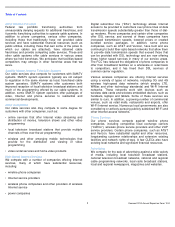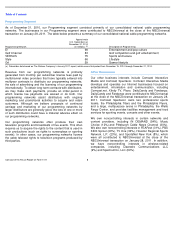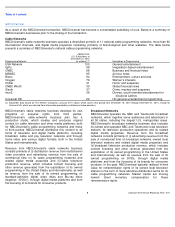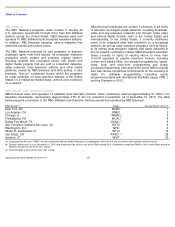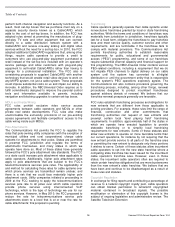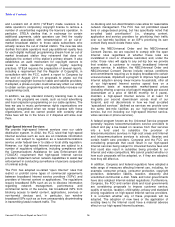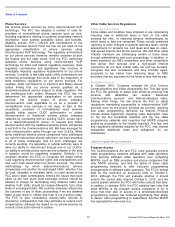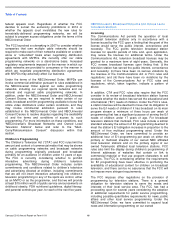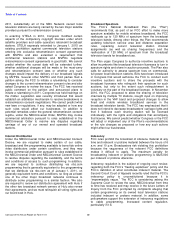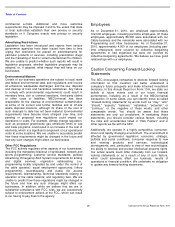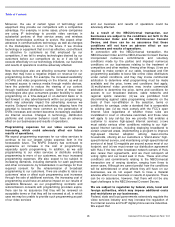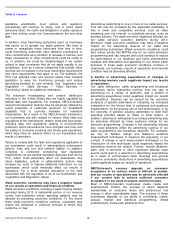Comcast 2010 Annual Report Download - page 21
Download and view the complete annual report
Please find page 21 of the 2010 Comcast annual report below. You can navigate through the pages in the report by either clicking on the pages listed below, or by using the keyword search tool below to find specific information within the annual report.
Table of Contents
17
Comcast 2010 Annual Report on Form 10-
K
Phone Services
We provide phone services by using interconnected VoIP
technology. The FCC has adopted a number of rules for
providers of nontraditional phone services such as ours,
including regulations relating to customer proprietary network
information, local number portability duties and benefits,
disability access, E911, CALEA and contributions to the
federal Universal Service Fund, but has not yet ruled on the
appropriate classification of phone services using
interconnected VoIP technology. The regulatory environment
for our phone services therefore remains uncertain at both
the federal and the state levels. Until the FCC definitively
classifies phone services using interconnected VoIP
technology for state and federal regulatory purposes, state
regulatory commissions and legislatures may continue to
investigate imposing regulatory requirements on our phone
services. Currently, a few state public utility commissions are
conducting proceedings that could lead to the imposition of
state telephone regulations on our phone services. For
example, state commissions in Vermont and Maine issued
orders finding that our phone service qualifies as a
telecommunications service subject to state regulation. We
are challenging both orders. Because the FCC has not
determined the appropriate classification of our phone
services, the precise scope of phone company
interconnection rules applicable to us as a provider of
nontraditional voice services is not clear. In light of this
uncertainty, providers of nontraditional voice services
typically either secure CLEC authorization or obtain
interconnection to traditional wireline phone company
networks by contracting with an existing CLEC, whose right,
as a telecommunications carrier, to request and obtain
interconnection with the traditional wireline phone companies
is set forth in the Communications Act. We have arranged for
such interconnection rights through our own CLECs. While
some traditional wireline phone companies have challenged
our right to interconnect directly with them, we have prevailed
in all of these challenges, and no such challenges are
currently pending. If a regulatory or judicial authority were to
deny our ability to interconnect through one of our CLECs,
our ability to provide phone services and compete in the area
in question would be negatively impacted. Similarly, it is
uncertain whether the FCC or Congress will adopt further
rules regarding interconnection rights and arrangements and
how such rules would affect our phone services. The entire
methodology by which telecommunications carriers
compensate one another for exchanged traffic, whether it be
for local, intrastate or interstate traffic, is under review at the
FCC and in state commissions. Among the issues that could
affect us are how much local exchange carriers should be
allowed to charge for terminating long distance traffic and
whether VoIP traffic should be treated differently from other
kinds of exchanged traffic. We could be adversely affected by
the outcome of any of these proceedings if we are deemed
liable to pay more or collect less than is our practice today.
The FCC is also considering industry-wide reforms of
intercarrier compensation that may eliminate or reduce such
compensation, although the impact on our phone services as
a result of any such reforms is unclear.
Other Cable Services Regulations
State and Local Taxes
Some states and localities have imposed or are considering
imposing new or additional taxes or fees on the cable
services we offer, or imposing adverse methodologies by
which taxes or fees are computed. These include combined
reporting or other changes to general business taxes, central
assessments for property tax, and taxes and fees on video,
high-speed Internet and phone services. We and other cable
industry members are challenging certain of these taxes
through administrative and court proceedings. In addition, in
some situations our DBS competitors and other competitors
that deliver their services over a high-speed Internet
connection do not face similar state tax and fee burdens.
Congress has also considered, and may consider again,
proposals to bar states from imposing taxes on DBS
providers that are equivalent to the taxes or fees that we pay.
Disabilities Access
In October 2010, Congress enacted the 21st Century
Communications and Video Accessibility Act. This law gives
the FCC the authority to adopt rules aimed at ensuring that
persons with disabilities can access “advanced
communications services” and Internet-delivered video.
Among other things, the law directs the FCC to adopt
regulations mandating accessibility to interconnected VoIP
services such as the phone services we provide, requiring
that video programming delivered via Internet Protocol
include closed captioning, imposing video description rules
on the top four broadcast networks and top five cable
programming networks and requiring that MVPD program
guides be accessible to the visually impaired. This law, and
any regulations ultimately adopted by the FCC, may impose
substantial additional costs and obligations on our
businesses.
Cable Programming Networks
Program Access
The Communications Act and FCC rules generally prevent
cable programming networks affiliated with cable operators
from favoring affiliated cable operators over competing
MVPDs, such as DBS providers and phone companies that
offer MVPD services, and limit the ability of these cable
programming networks to offer exclusive programming
arrangements to affiliated cable operators. The FCC’s sunset
date for this restriction on exclusivity ends on October 5,
2012, although the FCC will evaluate whether it should
extend the sunset date beyond October 5, 2012, and we
cannot predict whether the FCC will further extend that date.
In addition, in January 2010, the FCC adopted new rules that
allow MVPDs to file program access complaints to try to
show that their lack of access to a terrestrially-delivered
programming network has hindered significantly their ability
to deliver video programming to subscribers. Another MVPD
has appealed the new rules to a


